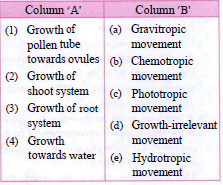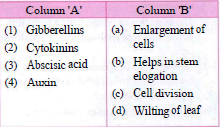Complete Solutions to EXAMPLE of chapter Life Processes In Living Organisms of Class 9 book with complete answers and questions
| Class 9 | BIOLOGY |
| Chapter | Life Processes In Living Organisms |
| CHETANA PUBLICATION | EXAMPLE |
| Number Of Questions | 100 |
| Academic Year | 2023-24 |
How do the digestive system and respiratory system work ?
View SolutionPreviously you have performed the activity of observing a branch covered in a plastic bag. What did you observe in that activity?
View SolutionSelect the odd man out:
Skin, Brain, Kidneys, Lungs.
View SolutionSelect the odd man out:
Gum, Resin, Urea, Latex
View SolutionSelect the odd man out:
Gibberellin, Auxin, Thyroxine, Cytokinin.
View SolutionSelect the odd man out:
Dendrite, Cell body, Axon, Synapse.
View SolutionSelect the odd man out:
Thyroxine, Calcitonin, Insulin, Auxin.
View SolutionComplete the Analogy:
Water : Xylem : : Food : ………… .
View SolutionComplete the Analogy:
Movement of root system : Gravitropic : : Movement of shoot system: ………….. .
View SolutionComplete the Analogy:
Brain:CranialCavity::SpinalCord : …………. .
View SolutionComplete the Analogy:
Cavities of the brain : Ventricles : : Cavities of the spinal code: …………. .
View SolutionComplete the Analogy:
Involuntary activities : Medulla oblongata : :Balance of the body: ………… .
View SolutionComplete the Analogy:
Stem elongation: Gibberellin : : Cell division : ………… .
View SolutionComplete the Analogy:
Control of voluntary movements : Cerebrum : : Co-ordination of voluntary movements: ………. .
View SolutionComplete the Analogy:
Converts glucose to glycogen : Insulin : : Converts glycogen to glucose: …………. .
View SolutionComplete the Analogy.
Seconday sexual characters in males: Testosterone :: Secondary sexual characters in females: ………… .
View SolutionMatch the columns:

View SolutionMatch the columns:

View SolutionMatch the columns:

View SolutionState whether the following statements are true or false. Correct the false statements.
Plants need less energy as compared to animals.
View SolutionState whether the following statements are true or false. Correct the false statements.
Xylem conducts food whereas phloem conducts water.
View SolutionState whether the following statements are true or false. Correct the false statements.
The loss of water from the plants is known as translocation.
View SolutionState whether the following statements are true or false. Correct the false statements.
Calcium oxalate crystals present in some plants are called resins.
View SolutionState whether the following statements are true or false. Correct the false statements.
Root pressure helps to push the water up in plants during night time.
View SolutionState whether the following statements are true or false. Correct the false statements.
Translocation is carried out by phloem in downward direction.
View SolutionState whether the following statements are true or false. Correct the false statements.
In unicellular organisms, waste materials are directly eliminated across the cell surface.
View SolutionState whether the following statements are true or false. Correct the false statements.
Urea is produced in the liver.
View SolutionState whether the following statements are true or false. Correct the false statements.
Systematic regulation of different processes is called co-ordination.
View SolutionState whether the following statements are true or false. Correct the false statements.
A hormone auxin produced in the apical part of the shoot helps in enlargement of cells.
View SolutionState whether the following statements are true or false. Correct the false statements.
Gibberellin helps in prevention and retardation of growth, leaf wilting etc.
View SolutionState whether the following statements are true or false. Correct the false statements.
The movement shown by venus fly trap while trapping an insect is a growth relevant movement.
View SolutionState whether the following statements are true or false. Correct the false statements.
The lotus flower opens during night time while that of tuberose (polyanthus) opens during day time.
View SolutionState whether the following statements are true or false. Correct the false statements.
Sensory neurons conduct impulses from the brain and the spinal cord to effector organs like muscles or glands.
View SolutionState whether the following statements are true or false. Correct the false statements.
There are 31 pairs of cranial nerves.
View SolutionState whether the following statements are true or false. Correct the false statements.
Activities like heart beat, blood circulation, breathing, sneezing, etc. are controlled by cerebellum.
View SolutionState whether the following statements are true or false. Correct the false statements.
Spinal nerves are associated with head, thorax and abdomen.
View SolutionState whether the following statements are true or false. Correct the false statements.
Nerve impulses are slow and long lasting whereas action of hormones is fast and short lived.
View SolutionState whether the following statements are true or false. Correct the false statements.
Reflex actions are controlled by cerebellum.
View SolutionState whether the following statements are true or false. Correct the false statements.
Thyroid stimulating hormone is secreted by the pituitary gland.
View SolutionState whether the following statements are true or false. Correct the false statements.
The hormone thymosin is secreted by the thyroid gland.
View SolutionState whether the following statements are true or false. Correct the false statements.
Parathormone controls metabolism of calcium and phosphorus.
View SolutionState whether the following statements are true or false. Correct the false statements.
The right kidney is slightly lower than the left kidney.
View SolutionName the structural and funcation unit of nervous system.
View SolutionName the following
The network of capillaries in the Bowman's capsule.
View SolutionName the following:
The minute space between two adjacent neurons.
View SolutionName the following:
The special cells which bring about control and co-ordination.
View SolutionName the following:
The cavities present in various parts of the brain.
View SolutionName the following:
The long tubular cavity of the spinal cord.
View SolutionName the following:
The thread like fibrous structure at the end of the spinal cord.
View SolutionGive scientific reasons:
It is necessary to remove harmful and waste substances from the body.
View SolutionGive scientific reasons:
In plants like Touch-me-not (Mimosa), movement also occurs at the places other than where it has been touched.
View SolutionGive scientific reasons:
Endocrine glands are also called ductless glands.
View SolutionDefine the following:
Transportation
View SolutionDefine the following:
Control
View SolutionDefine the following:
Coordination
View SolutionDefine the following:
Tropism or Tropic movement
View SolutionDefine the following:
Excretion
View SolutionDefine the following:
Dialysis
View SolutionDefine the following:
Reflex action
View SolutionDefine the following:
Homeostasis
View SolutionDefine the following:
Tropism or Tropic movement
View SolutionDistinguish between:
Excretory system of plants and animals.
View SolutionDistinguish between:
Nervous control and Chemical control
View SolutionDistinguish between:
Growth relevant movements and growth irrelevant movements
View SolutionDistinguish between cerebrum and cerebellum.
View SolutionWrite short notes:
Root Pressure
View SolutionWrite short notes:
Transpiration
View SolutionWrite short notes:
Nerve cell
View SolutionWrite short notes:
Reflex action
View SolutionWrite short notes:
Spinal cord
View SolutionWrite short notes:
Dialysis
View SolutionDraw neat and labelled diagram:
Human endocrine glands
View SolutionDraw neat and labelled diagram:
Human Brain
View SolutionDraw neat and labelled diagram:
Nephron
View SolutionDraw neat and labelled diagram:
Nerve cell
View SolutionDraw neat and labelled diagram:
Human excretory system
View SolutionDraw neat and labelled diagram:
Vertical Section of Kidney
View SolutionDraw neat and labelled diagram:
Reflex action
View SolutionName the hormones of the following endocrine glands and the fundtion of each:
Pituitary:
View SolutionName the hormones of the following endocrine glands and the fundtion of each:
Thyroid
View SolutionName the hormones of the following endocrine glands and the function of each:
Adrenal
View SolutionName the hormones of the following endocrine glands and the fundtion of each:
Thymus
View SolutionName the hormones of the following endocrine glands and the fundtion of each:
Testis
View SolutionName the hormones of the following endocrine glands and the function of each:
Ovary
View SolutionName the hormones of the following endocrine glands and the function of each:
Parathyroid
View SolutionName the hormones of the following endocrine glands and the fundtion of each:
Pancreas
View SolutionState the functions of different parts of the brain.
View SolutionWhich are the sensory organs of an organism? What is their function?
View SolutionWhere are the gustatory and olfactory nerves to be found?
View SolutionHow is excretion in plants useful to human beings?
View SolutionHow do plants bring about movements in them?
View SolutionHow does excretion occur in human being?
View SolutionWhat are growth-irrelevant movements? Give examples.
View SolutionWhich are the different types of nerve cells or neurons?
OR
How are nerve cells classified according to their functions?
View SolutionWhat are the different parts of the human nervous system?
View SolutionDescribe the structure of the central nervous system.
View SolutionWhich are the two types of peripheral nerves?
View SolutionHow do plants get rid of their excretory products?
View SolutionWhy do we eat fruits and vegetables? Do the plants also need minerals like we do?
View SolutionFrom where do plants get inorganic substances other than carbon dioxide and oxygen?
View Solution
EXAMPLE questions and complete solutions for chapter Life Processes In Living Organisms of CHETANA PUBLICATION of Class 9